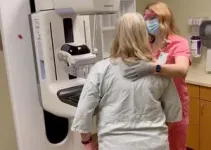(Press-News.org) COLUMBUS, Ohio -- An overwhelming majority of adults (93%) recognize a lump as a symptom of breast cancer, but less than half recognize other common symptoms associated with the disease, according to a consumer survey commissioned by The Ohio State University Comprehensive Cancer Center - Arthur G. James Cancer Hospital and Richard J. Solove Research Institute (OSUCCC – James).
Experts say this is very concerning, since most breast cancers do not present with a lump that can be detected by touch – and if they do, it often an indicates a fast-growing or advanced-stage cancer that is less treatable.
“Screening mammography is our No. 1 defense in detecting and addressing breast cancers at their earliest, most treatable stages, but it is also very important for people to be familiar with the look and feel of their own breast tissue so that sometimes subtle changes can be evaluated quickly to give us the best chance at early detection,” said Ashley Pariser, MD, a breast medical oncologist and director of breast cancer survivorship services at the OSUCCC – James.
“We want people to feel empowered about their bodies and know what is normal for them. Many breast changes are the result of aging and childbirth; however, breast cancer can present in a number of ways,” said Pariser. “It is important that people feel safe to address these concerns in a timely way with their doctor. We have made great strides in detecting breast cancers in far earlier, more treatable stages.”
These lesser-known symptoms of breast cancer include:
retracted, inverted or downward-pointing nipple
breast puckering (an indentation that appears when you raise your arms)
loss of feeling in part of the breast
pitting/thickening of the skin on the breast
nipple discharge
In this new survey, just 31% of survey respondents recognized a retracted, inverted or downward-pointing nipple as a symptom of breast cancer, and just 39% recognized breast puckering as a symptom. Less than half of survey respondents were aware of loss of breast feeling (41%), pitting/thickening of the breast skin (45%) or nipple charge (51%) as concerns worthy of medical attention.
Confusion about breast cancer screening guidelines
Pariser noted that screening mammography remains the No. 1 tool for early detection, yet new survey results show that a third of women say they are confused about recommendations for breast cancer screenings, particularly those under age 30 (44%).
“The best way for us to find breast cancer early is for women to present as soon as they notice a change, ideally even before they see a change. So that's why we recommend screening mammograms for those who qualify if we want to find breast cancer early,” said Pariser, who also is an assistant professor in the College of Medicine and an affiliate member of the Cancer Control Program at the OSUCCC – James.
The American College of Radiology and American College of Obstetrics and Gynecologists recommend begin screening at age 40 for people of average risk. OSUCCC – James breast cancer experts encourage each person to talk with their physician about their personal cancer risk and family history to personalize their screening plan.
Pariser notes that people with dense breast tissue should be closely monitored because they are at slightly higher risk and dense tissue can mask small tumors. Black and Ashkenazi Jewish people should also have a conversation about more intensive screening due to higher risk.
‘Won’t happen to me’ mentality
According to the American Cancer Society, breast cancer remains the most common cancer diagnosed in women behind skin cancers, with just under 300,000 new cases and 43,000 deaths expected in 2023. This new consumer survey, however, shows that few believe they will get the disease, which afflicts about one in eight women. Among respondents, 75% of women and 91% of men don’t believe they will get breast cancer.
“So, although we are making great strides in terms of detection and treatment, unfortunately we live in a world where breast cancer is still a serious concern for people,” said Pariser. “Although the disease is less common in men, 1% of breast cancers occur in men. These cancers typically present as nipple changes, so it is also important that men feel empowered to seek medical attention for concerning symptoms, especially if they have a strong family history of breast cancer.”
Study results and methodology
This study was conducted on behalf of The Ohio State University Wexner Medical Center/OSUCCC – James by SQL Server Reporting Services (SSRS) on its Opinion Panel Omnibus platform. The SSRS Opinion Panel Omnibus is a national, twice-per-month, probability-based survey. Data collection was conducted from Sept. 22-24 among a sample of 1,004 respondents. The survey was conducted via web (n=974) and telephone (n=30) and administered in English. The margin of error for total respondents is +/- 3.5 percentage points at the 95% confidence level. All SSRS Opinion Panel Omnibus data are weighted to represent the target population of U.S. adults ages 18 or older.
Breast cancer screening is available at more than a dozen locations across Columbus and the surrounding communities. To learn more about breast cancer treatment and research at the OSUCCC – James, visit cancer.osu.edu/breastcancer or call 1-800-293-5066.
###
END
An international team of interdisciplinary researchers has successfully created a method for better 3D modelling of complex cancers.
The University of Waterloo-based team combined cutting-edge bioprinting techniques with synthetic structures or microfluidic chips. The method will help lab researchers more accurately understand heterogeneous tumours: tumours with more than one kind of cancer cell, often dispersed in unpredictable patterns.
Traditionally, medical practitioners would biopsy a patient’s tumour, extract cells, and then ...
UK will struggle to build new AI models that compete with ChatGPT and big US tech firms, despite the government's “Frontier AI Taskforce”, say researchers.
To boost the economy, UK should focus on developing products that apply “generative AI” to daily life, including tax breaks for businesses investing in AI skills.
Legislation regulating AI safety and transparency is needed, so British industry and education can confidently put time and resource into AI development.
The British government should offer tax breaks for businesses developing AI-powered products and services, or applying AI ...
Antarctic fur seals that were hunted to near extinction have recovered but now face dangerous decline because of a lack of food, new research suggests.
The study of fur seals, almost all of which live on the sub-Antarctic islands of South Georgia, shows that the modern-day population peaked in 2009 at about 3.5 million – a healthy number, although significantly less than previously estimated. But a more detailed count of animals living on a particular South Georgia island called Bird Island also shows the seals are ...
Researchers have gained new insights into the lives and losses of Eurasian otters in Hong Kong, as detailed in a paper published by Oryx—The International Journal of Conservation, published by Cambridge University Press on behalf of international wildlife conservation charity Fauna & Flora.
Hong Kong is one of the world’s busiest metropolises, and the Eurasian otter Lutra lutra is among its most threatened wildlife. Dependence on lowland wetlands makes it particularly susceptible to human disturbance. Moreover, the low-lying region within Hong Kong where most otters can be found has been earmarked for a government-led mega ...
SAN FRANCISCO — Although people with opioid use disorder (OUD) are significantly more likely to overdose or have a complication after major surgery than those without the disorder, using medications for the treatment of OUD before surgery may eliminate that extra risk, suggests a large, first-of-its-kind study presented at the ANESTHESIOLOGY® 2023 annual meeting.
Patients with OUD who didn’t use an OUD medication (such as buprenorphine or methadone) were over four times more likely to overdose after having surgery, yet those who used evidence-based OUD medication ...
(16 October 2023, Copenhagen, Denmark) A groundbreaking new study, presented today at UEG Week 2023, has discovered a significant connection between birthweight and the onset of nonalcoholic fatty liver disease*, now known as metabolic dysfunction-associated steatotic liver disease (MASLD), in young people.1 Most notably, babies with a low birthweight were found to be four times more likely to develop MASLD in childhood, adolescence or young adulthood.1
To investigate this link, a team of researchers from Sweden used the nationwide ESPRESSO cohort and conducted a population-based case-control study of all ...
(Monday, 16 October 2023, Copenhagen, Denmark) New research has identified significant variations in the gut microbiome of individuals who developed pre-cancerous colonic lesions, suggesting a potential connection between gut bacteria and the onset of colorectal lesions and cancers.1 These findings, presented today at UEG Week 2023, open promising new avenues for enhancing the detection and prevention of colorectal cancer.1
The large-scale prospective study, involving 8208 participants, linked data from the Dutch Microbiome ...
SAN FRANCISCO — About 12,000 Black and Hispanic patients who died after surgery the past two decades may have lived if there were no racial and ethnic disparities among Americans having surgery, suggests a study of more than 1.5 million inpatient procedures presented at the ANESTHESIOLOGY® 2023 annual meeting. This estimate draws attention to the human toll of disparities in surgical outcomes, with Black patients being 42% more likely and Hispanic patients 21% more likely to die after surgery compared to white patients.
Unless efforts to narrow the racial and ethnic gap in surgical outcomes intensify, ...
ROCKVILLE, Md.— After 12 initial weeks of weight loss with intensive lifestyle intervention alone, participants in the SURMOUNT-3 study who were randomly assigned to tirzepatide for 72 weeks achieved a total mean reduction in baseline body weight of 24.3% at week 84. Results of the study, conducted by Eli Lilly & Company, will be presented during the 41st Annual Meeting of The Obesity Society (TOS) at ObesityWeek® 2023 scheduled for Oct. 14–17, in Dallas, Texas. The study will be published in the journal Nature Medicine and publication will coincide with the presentation at the conference.
"These are extraordinary findings, ...
SAN FRANCISCO — Blood management programs that reduced or avoided transfusions saved a health system millions of dollars annually, with a return on investment of more than $7 for every dollar spent, while achieving the same or better outcomes, suggests research presented at the ANESTHESIOLOGY® 2023 annual meeting.
Over the past 10 years, the Johns Hopkins Health System established a comprehensive blood management program with two primary goals: 1) to reduce unnecessary transfusions across the five-hospital health system, and 2) to ...

